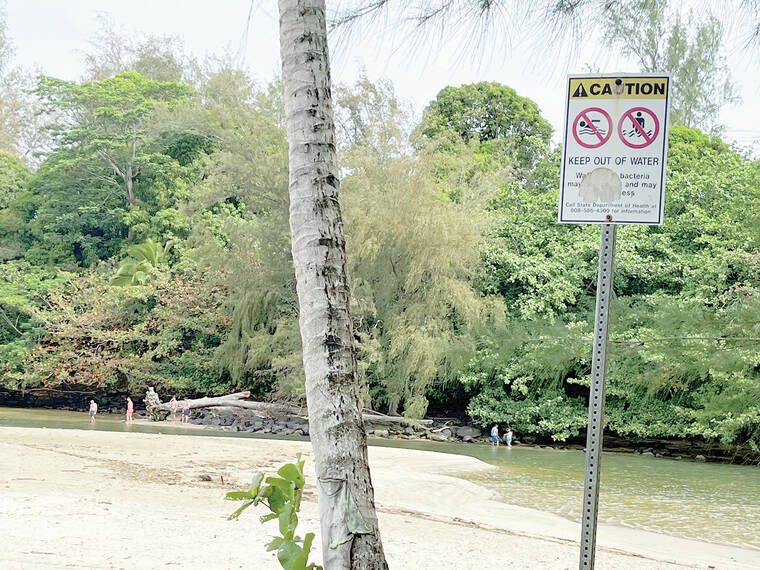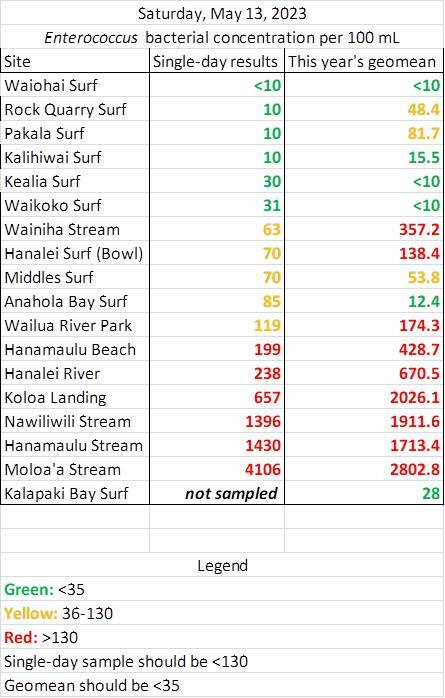LIHU‘E — Environmental organization Surfrider Kaua‘i’s Blue Water Task Force has found continued bacterial contamination of Kaua‘i’s streams and surf sites, as researchers fear possible fecal presence throughout much of the island’s waters.
Every month, Surfrider Kaua‘i analyzes samples of streams, rivers and surf sites across the island to check for the enterococcus bacterium, a federally recognized indicator of fecal presence in water.
Test results taken on May 13 found that six of the 17 sampled sites — Hanama‘ulu Beach, Hanalei River, Koloa Landing, Nawiliwili Stream, Hanama‘ulu Stream and Moloa‘a Stream — all exceeded state single-day standards of over 130 enterococci per 100 milliliters of water, with the latter three sites containing more than 10 times the state’s bacterial standard.
The most contaminated site tested, Moloa‘a Stream, now has a year-to-date average contamination of 2,802 enterococci per 100 milliliters — placing it more than 80 times above the state’s annual standard.
Surfrider Kaua‘i senior scientist Carl Berg told The Garden Island that the numerous homes — and therefore, numerous cesspools — along the stream’s floodplain are a major contributor to the waterway’s rampant bacterial contamination.
“The property owners down there know how bad it smells,” he said. “They know how bad it is.”
Kaua‘i’s waters are primarily polluted through two sources — surface runoff and cesspools. Above ground, rainwater washes animal feces and other open-air contaminants into the island’s rivers. Beneath the surface, rainwater percolates through the ground, pulling human and chemical waste — largely from Kaua‘i’s 14,000 cesspools — into the waters.
As the fecal materials enter the island’s recreational waters, swimmers and surfers often come in contact with this waste — including excreted pathogens.
“You can get infections in your eyes, ears and throat from the soup of bacteria and viruses that are in human-contaminated waters,” Berg said. “And if you swallow any of that water, it’s going to go into your gut and upset all the normal bacteria that are in there … so you can have diarrhea and vomiting.”
Rarer but far more concerning is leptospirosis, a potentially fatal disease that typically infects individuals via open wounds and can be found in infected waters.
“That can cause shutdown of your liver and kidneys, it can cause sepsis, you could lose a leg,” Berg said. “We have a history of lepto being in most of our waters, and people getting it. I think if you go on the North Shore, you ask anybody, ‘Do you know anyone who’s had lepto?,’ they’ll say yes.”
In an effort to limit fecal and chemical pollution, the state Legislature passed Act 125 in 2017, which requires all 88,000 of Hawai‘i’s cesspools to be replaced by 2050. At least three bills to incentivize such upgrades were introduced this year, including moving the deadline to 2040, creating a tax credit for cesspool upgrades and establishing a pilot program for expanding sewage systems — but all ultimately died in committee.
In the short term, Berg and Surfrider advocate for increased public awareness of polluted waters through installed signage at chronically polluted sites. While Surfrider and the state Department of Health have placed signs at some sites, such as Moloa‘a Stream and Hanama‘ulu Beach, indicating the potential presence of pathogens, Berg notes that no warning signs are present at sites like Nawiliwili and Waikomo streams — both of which are often frequented by families with children.
“The Department of Health should put up signs, and then (beachgoers) should make a choice of whether they want to swim in polluted water or not,” Berg said.
Additionally, Berg suggests Kaua‘i’s water enthusiasts remember two simple rules to protect against waterborne illness: “Stay out of polluted water, and if you do go surfing in it, make sure you rinse off as soon as you come out,” he said.
•••
Jackson Healy, reporter, can be reached at 808-647-4966 or jhealy@thegardenisland.com.




Google: “Feds Debunk Surfrider’s Fake Bacteria Counts”
Could these experts explain if it’s human or animal waste. What percentage is human and what percentage is animal?